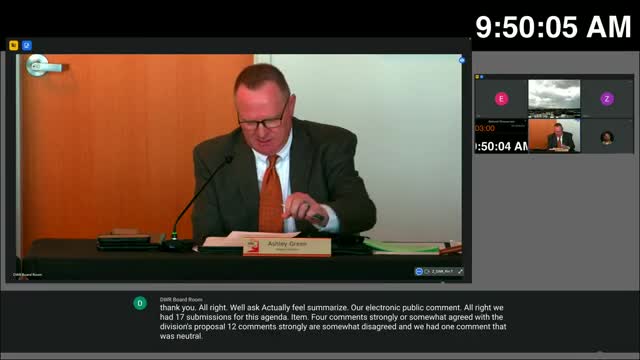Wildlife Board debates black bear hunting permits amid concerns over population management
January 09, 2025 | Utah Department of Natural Resources, Utah Government Divisions, Utah Legislative Branch, Utah
This article was created by AI summarizing key points discussed. AI makes mistakes, so for full details and context, please refer to the video of the full meeting. Please report any errors so we can fix them. Report an error »

On January 9, 2025, the Utah Wildlife Board convened to discuss critical recommendations regarding black bear hunting permits, reflecting ongoing tensions between conservation efforts and hunting regulations. The meeting highlighted a divide among stakeholders, with some supporting the proposed permit changes while others raised concerns about the sustainability of bear populations.
The board received mixed public feedback on the black bear permit recommendations. Supporters, including the Safari Club International, advocated for allowing multi-season permit holders to hunt during the harvest objective season and for the use of metal containers when baiting. They emphasized that science-based conservation through regulated hunting is vital for wildlife management and funding for conservation initiatives.
Conversely, several comments expressed opposition to the proposed permit increases, citing concerns over the high percentage of female bears in the harvest and the potential overexploitation of the population. Critics argued that the recommendations lacked a solid scientific foundation and were influenced by political pressures. Specific concerns were raised about outdated population data and the impact of recent drought conditions on bear numbers.
The board's discussions were marked by a series of motions across various regions, reflecting the complexity of managing bear populations. In the southern region, a motion to accept the recommendations as presented failed narrowly, while a motion to approve baiting regulation changes passed. The southeastern region saw a unanimous decision to create a plan for additional bear hunting opportunities on private lands, indicating a proactive approach to meet management objectives.
In the northeast, discussions centered on adjusting bear tag strategies due to difficulties in locating bears, with a motion to maintain current tag levels passing amid concerns about population pressures. The central region focused on ensuring that limited entry harvests would not count against the overall harvest quota, while the northern region addressed baiting regulations on Forest Service lands.
The meeting underscored the ongoing challenges in balancing hunting opportunities with wildlife conservation. As the board moves forward, the implications of these discussions will be closely monitored by both conservationists and hunting advocates, highlighting the need for continued dialogue and data-driven decision-making in wildlife management.
The board received mixed public feedback on the black bear permit recommendations. Supporters, including the Safari Club International, advocated for allowing multi-season permit holders to hunt during the harvest objective season and for the use of metal containers when baiting. They emphasized that science-based conservation through regulated hunting is vital for wildlife management and funding for conservation initiatives.
Conversely, several comments expressed opposition to the proposed permit increases, citing concerns over the high percentage of female bears in the harvest and the potential overexploitation of the population. Critics argued that the recommendations lacked a solid scientific foundation and were influenced by political pressures. Specific concerns were raised about outdated population data and the impact of recent drought conditions on bear numbers.
The board's discussions were marked by a series of motions across various regions, reflecting the complexity of managing bear populations. In the southern region, a motion to accept the recommendations as presented failed narrowly, while a motion to approve baiting regulation changes passed. The southeastern region saw a unanimous decision to create a plan for additional bear hunting opportunities on private lands, indicating a proactive approach to meet management objectives.
In the northeast, discussions centered on adjusting bear tag strategies due to difficulties in locating bears, with a motion to maintain current tag levels passing amid concerns about population pressures. The central region focused on ensuring that limited entry harvests would not count against the overall harvest quota, while the northern region addressed baiting regulations on Forest Service lands.
The meeting underscored the ongoing challenges in balancing hunting opportunities with wildlife conservation. As the board moves forward, the implications of these discussions will be closely monitored by both conservationists and hunting advocates, highlighting the need for continued dialogue and data-driven decision-making in wildlife management.
View full meeting
This article is based on a recent meeting—watch the full video and explore the complete transcript for deeper insights into the discussion.
View full meeting

